Global Horizontal Irradiance Prediction using the Algorithm of Moving Average and Exponential Smoothing
Abstract
To reduce the discrepancy between the results of the expected data and the actual data, prediction is a procedure that is calculated systematically based on owned historical and present information. For the creation of solar energy projects and for decision-making in other connected domains, solar radiation intensity prediction is essential. This study aims to create a predictive model on monthly global horizontal irradiance data. The method used is the Simple Moving Average algorithm, Exponentially Weighted Moving Average and Single Exponential Smoothing. The stages carried out in this study include data collection, data preprocessing, testing of predictive models, interpretation of data visualization, and performance evaluation. The results of calculating the error value and correlation produce an evaluation of the performance of the prediction model. The SES method, which obtained an MAE value of 7.13, a MAPE of 0.02%, an MSE of 88.07, an RMSE of 9.38, and an R2 of 0.94, was determined to be the best prediction model by the calculation of the prediction model performance evaluation. A MAE value of 9.45, a MAPE of 0.02%, an MSE of 150.16, an RMSE of 12.25, and an R2 of 0.91 were obtained by the EWMA method, which is also the method that produced the second-best result. A MAE value of 14.38, a MAPE of 0.04%, an MSE of 367.59, an RMSE of 19.17, and an R2 of 0.77 were obtained by the SMA method, which is the third-best result.
Keywords
Full Text:
PDFReferences
Y. Sianturi and C. M. Simbolon, "Pengukuran dan Analisa Data Radiasi Matahari di Stasiun Klimatologi Muaro Jambi," Megasains, vol. 12 No. 1, pp. 40-47, 2021. https://doi.org/10.46824/megasains.v12i1.45.
I. Morokia and A. S. Wauran, "Model Statistika Prediksi Energi Sur ya Dengan Menggunakan Autoregresif Integrated Moving Average (ARIMA)," JURNAL MIPA , vol. 8 No. 3, pp. 181-183, 2019. https://doi.org/10.35799/jmuo.8.3.2019.26193.
J. S. Setyono, F. H. Mardiansjah and M. F. K. Astuti, "Potensi Pengembangan Energi Baru dan Energi Terbarukan di Kota Semarang," Jurnal Riptek, vol. 13 No. 2, p. 177–186, 2019. https://doi.org/10.35475/riptek.v13i2.68.
A. Octavianti, Muliadia and Apriansyah, "Estimasi Intensitas Radiasi Matahari di Wilayah Kota Makassar," PRISMA FISIKA, vol. 6 No. 3, pp. 152-159, 2018. http://dx.doi.org/10.26418/pf.v6i3.28711.
Y. S. Utomo, "Prediksi Radiasi Surya Global Bulanan Kota Bandung Menggunakan Data LPM (Lama Penyinaran Matahari)," Jurnal Material dan Energi Indonesia, vol. 07 No. 2, p. 21–27, 2017. https://doi.org/10.24198/jmei.v7i02.15534.g7501.
A. A. Teyabeen, N. B. Elhatmi, A. A. Essnid and F.Mohamed, "Estimation of monthly global solar radiation over twelve major cities of Libya," Energy and Built Environment, pp. 1-12, 2022. https://doi.org/10.1016/j.enbenv.2022.07.006.
M. C. Brito, S. R. A. e and M. Po, "Geographical distribution of the angle of incidence uncertainty on the measurement of global horizontal irradiance," Measurement: Sensors, vol. 22 no. 100382, pp. 1-8, 2022. https://doi.org/10.1016/j.measen.2022.100382.
E. Setyowati, "Perbandingan Metode Exponential Smoothing dan Moving Average dalam Peramalan Retribusi Pengujian Kendaraan Bermotor di Dinas Perhubungan Kota Blitar," Jurnal Sains Dasar, vol. 11 no. 1, pp. 35-38, 2022. doi 10.21831/jsd.v11i1.44391.
A. Nurfadilah, W. Budi, E. Kurniati and D. Suhaedi, "Penerapan Metode Moving Average untuk Prediksi Indeks Harga Konsumen," Jurnal Matematika , vol. 21 no. 1 , pp. 19-25, 2022.
E. A. Gultom, N. Eltivia and N. I. Riwajanti, "Shares Price Forecasting using Simple Moving Average Method and Web Scrapping," Journal of Applied Business,Taxation and Economics Research (JABTER), vol. 2 no. 3, pp. 288-297, 2023. doi:10.54408/jabter.v2i3.164.
Munawar, A. Mulsandi and A. M. Hidayat, "Model Estimasi Data Intensitas Radiasi Matahari untuk Wilayah Banten," Jurnal Sains & Teknologi Modifikasi Cuaca, vol. 21 no. 2 , pp. 53-61, 2020. https://doi.org/10.29122/jstmc.v21i2.4171.
A. Octaviantia, Muliadia and Apriansyah, "Estimasi Intensitas Radiasi Matahari di Wilayah Kota Makassar," PRISMA FISIKA, vol. 6 no. 3, pp. 152-159, 2018. http://dx.doi.org/10.26418/pf.v6i3.28711.
N. L. Saria and T. Hasanuddina, "Analisis Performa Metode Moving AverageModel untuk Prediksi Jumlah Penderita Covid-19," Indonesian Journal of Data and Science(IJODAS), vol. 1 no. 3, pp. 87-95, 2020. https://doi.org/10.33096/ijodas.v1i3.19.
R. Ramadhan, R. Yusman and G. Pranoto, "Comparison of Holt Winters and Simple Moving Average Models to Identify The Best Model for Predicting Flood Potential Based on The Normalized Difference Water Index," JISA (Jurnal Informatika dan Sains), vol. 5 no. 2, pp. 99-105, 2022.
H. D. Wulandari, Mustafid and H. Yasin, "Penerapan Metode Exponentially Weighted Moving Average (EWMA) dalam Pengukuran Risiko Inevstasi Saham Portofolio untuk Volatilitas Heterogen," JURNAL GAUSSIAN, vol. 7 no. 3, pp. 248-259, 2018. https://doi.org/10.14710/j.gauss.7.3.248-259.
R. Yuniarti, "Analisa Metode Single Exponential Smoothing Sebagai Peramalan Penjualan Terhadap Penyalur Makanan (Studi Kasus : Lokatara Dimsum)," Jurnal Manajemen & Bisnis Aliansi, vol. 15 no. 2, pp. 29-34, 2020. https://doi.org/10.46975/aliansi.v15i2.63.
Risqiati, "Penerapan Metode Single Exponential Smoothing dalam Peramalan Penjualan Benang," Smart Comp , vol. 10 no. 3 , pp. 154-159, 2021. http://dx.doi.org/10.30591/smartcomp.v10i3.2887.
D. Gunawan and W. J. Kurniawan, "Perancangan Sistem Informasi Purchase Order Menggunakan Metode Single Exponential Smoothing," Jurnal Mahasiswa Aplikasi Teknologi Komputer dan Informasi, vol. 2 no. 1, pp. 13-18, 2020.
M. A. Maricar, "Analisa Perbandingan Nilai Akurasi Moving Average dan Exponential Smoothing untuk Sistem Peramalan Pendapatan pada Perusahaan XYZ," JURNAL SISTEM DAN INFORMATIKA, vol. 13 no. 2, pp. 36-45, 2019.
E. K. Hendarwati, P. Lepong and Suyitno, "Pemilihan Semivariogram Terbaik Berdasarkan Root Mean Square Error(Rmse) Pada Data Spasial Eksplorasi Emas Awak Mas," Jurnal Geosains Kutai Basin , vol. 6 no. 1, pp. 1-6, 2023.
D. Setiawan, E. Shafira, K. Ukar, D. B. Ginting and A. Rini, "Analisis Faktor-Faktor yang Mempengaruhi Perilaku Pengguna Aplikasi Tokopedia," Media Informatika, vol. 21 no.1 , pp. 75-93, 2022.
C. A. Rahmat, Kurniabudi and Y. Novianto, "Penerapan Metode Regresi Linier BergandaUntuk Mengestimasi Laju Pertumbuhan Penduduk Kabupaten Musi Banyuasin," Jurnal Informatika dan Rekayasa Komputer (JAKAKOM), vol. 3 no. 1, pp. 359-369, 2023.
DOI: https://doi.org/10.31326/jisa.v6i1.1649
Refbacks
- There are currently no refbacks.
Copyright (c) 2023 Alfin Syarifuddin Syahab, Arief Hermawan, Donny Avianto

This work is licensed under a Creative Commons Attribution-ShareAlike 4.0 International License.
JOURNAL IDENTITY
Journal Name: JISA (Jurnal Informatika dan Sains)
e-ISSN: 2614-8404, p-ISSN: 2776-3234
Publisher: Program Studi Teknik Informatika Universitas Trilogi
Publication Schedule: June and December
Language: English
APC: The Journal Charges Fees for Publishing
Indexing: EBSCO , DOAJ, Google Scholar, Arsip Relawan Jurnal Indonesia, Directory of Research Journals Indexing, Index Copernicus International, PKP Index, Science and Technology Index (SINTA, S4) , Garuda Index
OAI address: http://trilogi.ac.id/journal/ks/index.php/JISA/oai
Contact: jisa@trilogi.ac.id
Sponsored by: DOI – Digital Object Identifier Crossref, Universitas Trilogi
In Collaboration With: Indonesian Artificial Intelligent Ecosystem(IAIE), Relawan Jurnal Indonesia, Jurnal Teknologi dan Sistem Komputer (JTSiskom)
JISA (Jurnal Informatika dan Sains) is Published by Program Studi Teknik Informatika, Universitas Trilogi under Creative Commons Attribution-ShareAlike 4.0 International License.


















